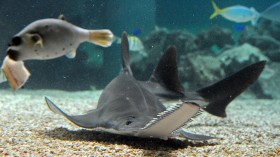For little penguins (Eudyptula minor), a successful breeding season is linked with an abundance of prey, a new study has shown.
A collaboration between Monash University's School of Biological Sciences and Phillip Island Nature Parks, both in Victoria, Australia, observed the breeding and diet habits of a colony of little penguins on an island on the Victoria coast for two years.
The researchers detailed how changes in the abundance of prey and other food sources influenced reproductive success by tracking the colony's behaviors during the 2010 and 2011 breeding season.
Prior research revealed that the staple of the colony's diet was anchovies, which accounted for 78 percent of their food source. Initially, the researchers predicted that any changes in the abundance of anchovies would affect the reproductive success of the colony, but they were surprised to find that the penguins were resilient to changes in anchovy stocks only if alternative prey, such as sardines, could be found.
"The St Kilda little penguin colony has a short foraging range and displays narrow dietary diversity so this gave us the unique ability to identify how changes in food supply influence their reproduction," said researcher Nicole Kowalczyk of Monash University.
"We found that a sharp decline of anchovy in 2010 had a negative impact on little penguin reproduction. However, in 2011, despite the relatively low anchovy abundance, their breeding success was extremely high.
"We believe the decrease of anchovy itself was not the only cause for low breeding success in 2010 but in combination with the scarcity of alternative prey. Our results show that little penguins are resilient to changes in their preferred prey but their ability to adapt to these changes is limited by the availability of alternative prey species."
A complete understanding of sea bird's diet is essential for proper species management, Kowalczyk said.
"Our results highlight that resource abundance and the availability of a variety of prey are critical factors in enabling this inshore seabird to adjust to changes in environmental conditions and fluctuations in their primary source of prey," Ms Kowalczyk said.
"Dietary changes have been linked to population declines and provide information about foraging conditions, particular prey species and foraging locations that require protection."
Kowalczyk and her colleagues' research is published in the journal Functional Ecology.
© 2024 NatureWorldNews.com All rights reserved. Do not reproduce without permission.
![Severe Thunderstorm Alert: Tornadoes, Damaging Winds and Hail Possible from Upper Ohio Valley to Northeast US [NWS]](https://1471793142.rsc.cdn77.org/data/thumbs/full/70161/280/157/50/40/severe-thunderstorm-alert-tornadoes-damaging-winds-and-hail-possible-from-upper-ohio-valley-to-northeast-us-nws.jpg)




